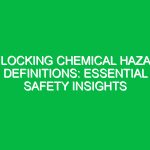Welcome to Today’s Toolbox Talk
Good morning, team! Today, we’re gathering for a critical toolbox talk focused on a topic that might seem simple but is vital to our Safety—Seatbelt Safety. Whether we’re driving company vehicles or commuting to job sites, understanding and practicing proper seatbelt use can save lives. Let’s dive into the importance of seatbelt safety, share some practical tips, and discuss how we can all contribute to a safer work Environment.
Why Seatbelt Safety Matters
Every year, thousands of accidents occur on the road, and a significant number of these accidents result in severe injuries or fatalities. According to the National Highway Traffic Safety Administration (NHTSA), seatbelts reduce the risk of death by 45% for front-seat passengers. In the context of our work, this statistic is particularly important. Many of us are on the road throughout the day, traveling between job sites or to meet clients. By wearing seatbelts, we not only protect ourselves but also set a standard for safety within our team.
The Fundamentals of Seatbelt Safety
Let’s review some fundamental aspects of seatbelt safety that everyone should know:
- Always Buckle Up: No matter how short the trip is, always wear your seatbelt. Accidents can happen in seconds.
- Proper Positioning: Ensure that your seatbelt fits snugly across your lap and chest. The lap belt should sit low on your hips, and the shoulder belt should cross the middle of your chest.
- Adjust Seat Settings: Before buckling up, adjust your seat and mirrors to ensure you can drive comfortably and see clearly.
- Check for Proper Function: Regularly check that your seatbelt is functioning correctly. If you notice any fraying or damage, report it immediately.
- Don’t Use Seatbelts Incorrectly: Avoid placing the shoulder strap behind your back or under your arm, as this can lead to severe injuries in an accident.
Real-Life Scenarios and Consequences
Let’s consider a few hypothetical scenarios to illustrate the importance of seatbelt safety:
- Scenario 1: Imagine a team member named John is driving to a job site. He decides not to buckle up because “it’s just a quick drive.” Suddenly, another driver runs a red light, and John crashes. His decision not to wear a seatbelt could lead to severe injuries. In contrast, if he had buckled up, he might have walked away with minor injuries.
- Scenario 2: In another case, a team vehicle is involved in an accident. Everyone inside is wearing their seatbelts, and although the car sustains damage, all passengers emerge without serious injuries. This scenario highlights how seatbelts can save lives.
Best Practices for Seatbelt Safety
To further enhance our commitment to seatbelt safety, here are some actionable Best Practices:
- Conduct Seatbelt Checks: Before starting any journey, ensure that all passengers are wearing their seatbelts.
- Lead by Example: As leaders within our team, we must model safe behavior. If you buckle up every time, your colleagues are more likely to do the same.
- Include Seatbelt Safety in Regular Training: Integrate discussions about seatbelt safety into your regular safety training sessions and toolbox talks.
- Encourage Open Dialogue: Foster an environment where team members feel comfortable discussing safety concerns or suggestions related to seatbelt use.
Understanding the Regulations and Standards
As we discuss seatbelt safety, it’s essential to mention the regulations that govern our practices. The Occupational Safety and Health Administration (OSHA) emphasizes the importance of using safety equipment, including seatbelts, in work vehicles. Non-compliance can lead to serious legal ramifications and fines for our company. Moreover, our company policy requires all employees to wear seatbelts while operating or riding in company vehicles. Adhering to these regulations not only keeps us safe but also protects the company legally.
Potential Hazards and Risks
Understanding the potential Hazards associated with not using seatbelts can help reinforce their importance:
- Increased Risk of Injury: The likelihood of sustaining serious injuries or fatalities dramatically increases without a seatbelt.
- Legal Consequences: Failing to wear a seatbelt can result in fines and penalties, which can impact both personal and company safety records.
- Emotional Impact: Being involved in an accident can have lasting psychological Effects on individuals, especially if it results in severe injury or death.
Encouraging Team Responsibility
As we wrap up our discussion on seatbelt safety, I want to emphasize that safety is a shared responsibility. Each one of us plays a role in fostering a culture of safety within our team. Here are some questions to consider:
- How can we better communicate the importance of seatbelt safety to new team members?
- What additional resources or training would help reinforce the importance of seatbelt use?
- Can we incorporate seatbelt checks into our daily routine before heading out for work?
Conclusion: The Path Forward
In conclusion, seatbelt safety is not just a personal choice; it’s a critical component of our Workplace Safety culture. By committing to wearing seatbelts, we protect ourselves and our colleagues. Remember, every time you buckle up, you’re making a conscious decision to prioritize safety. Thank you for your attention today, and let’s all commit to making our work environment as safe as possible. Together, we can ensure that everyone returns home safely at the end of each day.


